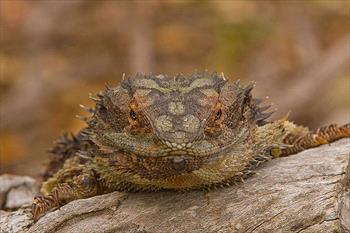Eastern Bearded Dragon

A relatively newly recognized and highly malignant cancer is being seen more and more often in captive bearded dragons (Pogona vitticeps). These tumors have been classified as gastric neuroendocrine carcinomas (GNT), which readily spread to other organs. Because these tumors have only begun to be seen recently, the best treatment is yet to be found.
GNT is found in the stomach and most commonly spreads to the liver. It is not known at this time how fast this spread occurs, but the GNT seems to spread quickly. Bearded dragons with GNT have general signs of illness that include reduced appetite, weight loss, vomiting, lethargy, anemia, bleeding from the cloaca (melena), blood seen in poop, and high blood glucose. In humans, dogs and cats, high blood glucose indicates diabetes. In reptiles, diabetes is an almost unheard of disease. A high blood glucose in a bearded dragon gives suspicion for a possible GNT.
When the organs of bearded dragons that died of GNT were looked at, signs of it could be seen without using a microscope in the stomach, liver, pancreas and kidney. When they were looked at under the microscope, tumors could be identified in the stomach with spread to the liver (most commonly), kidney, pancreas, intestine, heart, oviduct and ovary.
There is no known risk of infection to humans from bearded dragon GNT, so if you have a stomach ache don’t worry about this.
Affected Reptiles
So far only captive bearded dragons have been found with GNT. It seems to occur most often in young animals and it is being more commonly diagnosed each year.
Diagnosis
Bearded dragons with GNT are usually just sick. They have non-specific signs, or what pet owners sometimes call “ain’t doing right.” This means that your animal has signs of illness that could have many causes. Bearded dragons who aren’t hungry and are vomiting should have GNT on the list of possible diseases to rule out.
Your veterinarian will start by taking a thorough medical and husbandry history and give a physical examination. Blood will be taken for a complete blood count and plasma chemistry in addition to X-rays. The physical examination and X-rays may reveal a mass in the stomach, but if one is there it’s not always seen. The blood test will often show a high glucose level that would help with the diagnosis. However, not all bearded dragons with GNT have a high blood glucose. A biopsy of the stomach tissue looked at under the microscope will be able to diagnose the GNT; that needs to be sent to an outside laboratory for a definitive diagnosis.
Treatment
This is a relatively new disease in captive bearded dragons, and treatments are not really worked out yet. Unfortunately, the seemingly fast spread to other organs means the prognosis is poor, even after surgery to remove the stomach mass. Your veterinarian will discuss the options for attempted treatments and how to make your dragon more comfortable.
Prevention
There are no tests at this time that can screen for GNT in bearded dragons. Because high blood glucose is not a common finding in bearded dragons, it may be wise to screen young bearded dragons with a blood test for glucose levels. However, it’s not known how accurate or sensitive this screening would be. You can discuss this possibility with your veterinarian.